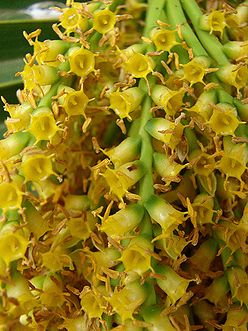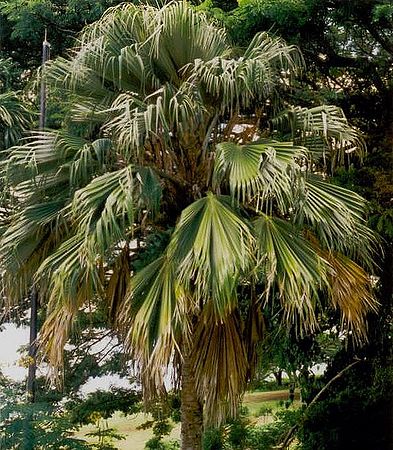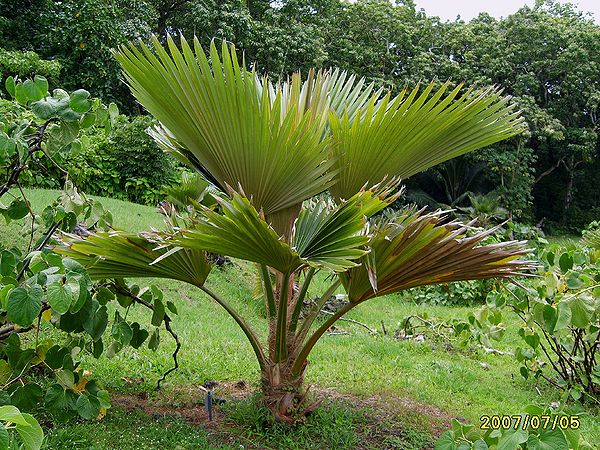Pritchardia arecina
| Pritchardia (pritch-AHR-dee-ah) arecina (ahr-eh-SEE-nah) | |||||||
|---|---|---|---|---|---|---|---|
 Hanamu Rd Makawao, Maui. Photo by Forest & Kim Starr | |||||||
| Scientific Classification | |||||||
| |||||||
| Synonyms | |||||||
|
| |||||||
| Native Continent | |||||||
|
| |||||||
| Morphology | |||||||
| |||||||
| Culture | |||||||
|
| |||||||
| Survivability index | |||||||
|
| |||||||
| Common names | |||||||
|
| |||||||
Contents
Habitat and Distribution
Hawaii. Wet forest on the north and northeastern slopes of Haleakala, East Maui, 450-1300 m elevation.Description
To 15 m tall, emergent; proximal margins of petiole with moderate to abundant fibers; leaf blade slightly undulate to nearly flat, divided 1/4-1/3, abaxial surface completely covered with lepidia and appearing silvery grayish while to somewhat reddish brown, segment tips stiff; inflorescences composed of 1 or 2 panicles, equaling to exceeding petioles in flower, exceeding petioles or equaling leaf blades in fruit, panicles branched to 2 orders, rachillae permanently clothed with dense, felt-like to nearly woolly indumentum; fruits 45 x 38-40 mm, ellipsoid/Palmweb. Editing by edric.
Pritchardia arecina is distinguished by its petioles with an abundance of fibers proximally, leaf blades completely covered abaxially with lepidia, and large fruits. It is I similar to the highly variable P. martii, but the latter differs in its petioles with irregularly shaped, papery ligules or wings or only a few fibers proximally. It is also somewhat similar to P. woodii, which occurs not too far to the southwest in East Maui but in slightly drier areas; P. wDodii, however, differs in its leaf blades incompletely covered abaxially with lepidia and petioles with only a few fibers proximally/Palmweb.
Culture
Propagation Information: Easy. Mature seeds buried half way in pot of clean, well drained potting soil, water daily, sprout in a few months, plants of 1 foot can be put in ground/larger pot; if many species are grown in same vicinity seeds become hybridized, hand pollinate to prevent this. (Bishop Museum Kalihi)
Pritchardia arecina is an easy to grow palm but not often available for the landscape. Pritchardia arecina vary in shape. Specimens raised in dry and/or infertile soils tend to be smaller in stature with smaller leaves. Light also affects the plant's form while those grown in full sun are more compact. This palm prefers a sunny, well drained, and moist location. Growth rate: It is a slow growing, short stocky palm. Soil: It likes organic soil, but is adaptable to clay and loam bolth slightly alkaline and acidic. Good drainage is also important. Fertilization: Need a perfect fertilizer diet including all micro nutrients and trace elements or slow release fertilizer. Micronutrient deficiencies are occasional problems. If it doesn't get enough Mn and Fe (Iron), the leaves take on a rather unhealthy yellow colour. Micronutrient deficiencies only show up on soil with a high pH. Fertilize often for faster growth. Water Requirements: Needs regular water, do not let dry out between waterings. however it does not want to sit in continually wet, mucky soil. The roots and lower trunk can rot if soil is kept too moist. Light: Prefers full sun but will tolerate half day sun. Hardiness: It is adapted to tropical and subtropical climates, young plants are more cold sensitive. Maintenance: Remove dead fronds and spent fruiting stalks for a clean landscape appearance. Fronds can be left on the palm to form a skirt for natural settings. Palms recycle nutrients from dead or dying fronds and use them for healthier fronds. Palms only have a set number of new leaves that can sprout and grow per year and removing fronds will not increase that number. If you cut off more than what will grow annually, you could be left with a pretty bare and bald palm. Pest & Disease: Mealybugs and whiteflies underneath the leaves can present problems at times if not kept in check. A generous spray of water can wash them off. Ornamental: It is cultivated as an ornamental tree, and planted in gardens and parks in tropical and sub-tropical climates either as a single specimen or in groups. Culture in containers is possible although growth rates are slower. A bright patio will provide an excellent environment for young specimens which can eventually be planted in a sunny location. (llifle.com)
Comments and Curiosities
| read more |
|---|
|
Etymology: Pritchardia name is dedicated to William Thomas Pritchard (1829-1907), British official stationed in Fiji in the 19th Century, British counsul in Fiji, adventurer, and author of Polynesian Reminiscences in 1866. The specific epithet arecina means Areca-like, in reference to its apparent likeness to fruit of the betel nut palm (Areca catechu). Uses: Loulu is used to treat ‘ea and pa‘ao‘ao in children and adults. The leaf bud and inner flesh are combined with niu (coconut, Cocos nucifera), kō kea (white sugarcane, Saccharum officinarum), ‘ōhi‘a bark (Metrosideros spp.) and ‘ala‘alawainui pehu (Peperomia spp). All of the items are pounded into a liquid form and drunk three times a day. Loulu palm were erected to signify a temporary, special 'heiau loulu', where gods of fishing were seasonally propitiated (Abbott 1992:17). one of the most elegant fans known from the Hawaiian Islands is thought to have been made partly from the loulu palm fronds. In the Ethnology Collection at Bishop Museum there is a hat that is likely made from loulu as well. (Bishop Museum Kalihi) After blooming large brown to black round to ovoid (Egg-shaped) fruits, at least 1 1/4 inches wide, will develop on hairy fruiting stalks nearly as long as the leaves. "Rare in cultivation, this Maui native has large, somewhat divided, wedge shaped fan leaves that tend to be pendant as palm ages. Leaf bases have thick tomentum of orange scurf. As far as I know, this palm hasn't been tried much in southern Caliofornia, but it should do OK here, as most Hawaiian Pritchardias do well here in SoCal." Geoff Stein) "Seeds collected from a stand of Pritchardia arecina growing in a native habitat in the rain forest of Kuhiwa at an elevation of approximately 3000 feet are identical to the ones off the tree in Nahiku. The lone tree in Nahiku was planted as part of an arboretum by Marion Cabral more than 50 years ago. Due to rats, pigs and worms in the area devouring the fallen seeds, no volunteers have ever established themselves under or near the parent tree." (Bill Chang) |
- IMAGE GALLERY
"In respect to the proliferation into many taxa or the adaptive radiation of the genus Pritchardia, and given that the specimen in Nahiku, shown in the photograph above, closely follows the description of the species, variations in the physical character of different specimen of the species arecina are apparent in the following cases." Photo by Bill Chang, edric.Nahiku, Hana, Maui. Photo by Bill Chang
"This mature specimen stands at the foot of Piilanihale Heiau in Honomaele at the Kahanu Garden. The segments are somewhat longer and slightly pendent. The seeds are significantly smaller that the 2 inches attributed to the species; the seeds from this tree are approximately 3/4 inch in diameter." Photo by Bill Chang
"The specimen pictured above shows significantly pendent segments. The seeds on this tree have been different sizes over the years. In 1990, when I first saw this tree, the seeds were only 3/4 inch in diameter, however, in 2006, the seeds were approximately 1 1/2 inches in diameter, twice the previous size." Photo by Bill Chang
"This mature specimen growing in my Wakiu garden is another descendant of the first tree pictured in this Maui chapter. The seeds produced by this tree range from 1/2 to 3/4 inch in diameter. The undersides of the leaves show the distinct gold tomentum around the hastula area on older leaves and a more silvery-white tomentum on the younger leaves. This specimen is approximately 10 years old. The parent tree grows at an elevation of approximately 1000 feet. The ovoid seeds off the parent tree are 2 inches in diameter, and are dark brown to black and shiny when ripe." Wakiu, Hana, Maui. Photo by Bill Chang
"This mature specimen of Pritchardia arecina growing in Kahanu Garden exhibits segments that are long and slightly pendent; it produces medium size seeds approximately 3/4 inch in diameter. This tree is quite similar to the specimen growing at the foot of Piilanihale Heiau, Kahanu, Maui." Photo by Bill Chang
"At Kahanu Garden, many young trees have been planted on the grounds in recent years. Even though the seeds originated from the same source, the seedlings are beginning to show some character differences as they mature. In the juvenite plants depicted here, differences in coloration, as well as leaf and petiole details are apparent. Kahanu Garden, Honomaele, Hana, Maui." Photo by Bill Chang
"At Kahanu Garden, many young trees have been planted on the grounds in recent years. Even though the seeds originated from the same source, the seedlings are beginning to show some character differences as they mature. In the juvenite plants depicted here, differences in coloration, as well as leaf and petiole details are apparent. Kahanu Garden, Honomaele, Hana, Maui." Photo by Bill Chang
"At Kahanu Garden, many young trees have been planted on the grounds in recent years. Even though the seeds originated from the same source, the seedlings are beginning to show some character differences as they mature. In the juvenite plants depicted here, differences in coloration, as well as leaf and petiole details are apparent. Kahanu Garden, Honomaele, Hana, Maui." Photo by Bill Chang
"This was the first loulu that I saw, it grows in the mountainside in Nahiku at about 1000 feet elevation. That's a little lower than its native habitat which starts 1000 feet above that and encompasses the eastern slopes of Haleakala on Maui to a maximum elevation of 4000 feet. There are several trees in the Garden at Wakiu that are offspring of this tree." Wakiu, Hana, Maui. Photo by Bill Chang
"This second photo is of Pritchardia arecina seeds from the mature tree that grows in my Wakiu garden. I believe the size difference is directly related to the elevation difference. Although the Nahiku tree is approximately 2000 feet lower in elevation than the Kuhiwa habitat, the climate is similar. Wakiu is about 120 feet in elevation, but it is also a drier climate and does not have as low temperatures in the winter as Nahiku and Kuhiwa." Photo by Bill Chang
External Links
- Glossary of Palm Terms
- MODERN BOTANICAL LATIN
- "Just To Be Clear"
- http://myloulu.wordpress.com/2010/09/13/the-island-of-oahu/
- http://myloulu.wordpress.com/2010/09/08/the-island-of-maui/
- http://myloulu.wordpress.com/2010/09/27/the-islands-of-niihau-and-nihoa/
- http://myloulu.wordpress.com/2010/09/06/the-island-of-hawaii/
- http://myloulu.wordpress.com/2010/09/21/the-island-of-kauai/
- http://myloulu.wordpress.com/2010/09/08/the-island-of-lanai/
- http://myloulu.wordpress.com/2010/09/08/island-of-molokai/
- http://hanapalms.wordpress.com/2010/07/
- http://www.biomedcentral.com/1471-2148/12/23
- http://www.palmtalk.org/forum/index.php?/topic/33686-loulu-the-hawaiian-pritchardia-and-then-some/
References
Phonetic spelling of Latin names by edric.
Special thanks to Geoff Stein, (Palmbob) for his hundreds of photos.
Special thanks to Palmweb.org, Dr. John Dransfield, Dr. Bill Baker & team, for their volumes of information and photos.
Glossary of Palm Terms; Based on the glossary in Dransfield, J., N.W. Uhl, C.B. Asmussen-Lange, W.J. Baker, M.M. Harley & C.E. Lewis. 2008. Genera Palmarum - Evolution and Classification of the Palms. Royal Botanic Gardens, Kew. All images copyright of the artists and photographers (see images for credits).
Many Special Thanks to Ed Vaile for his long hours of tireless editing and numerous contributions.



























































